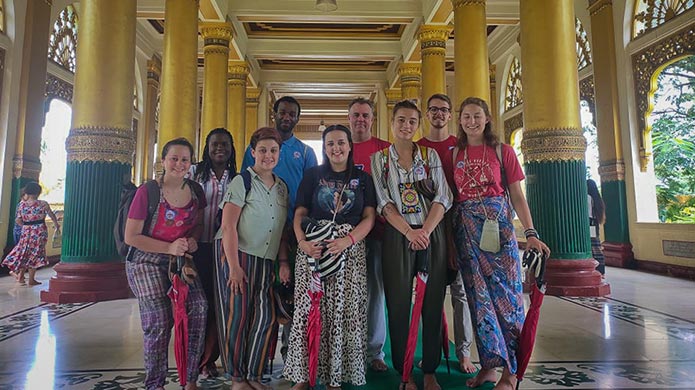Myanmar
Myanmar, formally known as Burma, is a country in Southeast Asia that is bordered by India, Bangladesh, China, Laos and Thailand, creating a unique blend of cultures and religions found nowhere else in Southeast Asia.
The Myanmar population is estimated at around 53 million people.
One very alluring aspect of Myanmar is that the country has many beautiful temples. Bagan, in particular, has the densest concentration of Buddhist temples and pagodas anywhere in Southeast Asia.
Choosing to teach English in Myanmar offers teachers a unique opportunity to immerse themselves and experience a new culture. Myanmar has only recently opened its doors to the outside world so visitors will find a rich history and vibrant landscapes that have remained untouched by the West until now.
History
Myanmar gained its independence in 1948.
From 1962 to 2011 the country was ruled by a military regime.
A coup d’état in Myanmar began on the morning of 1 February 2021, when democratically elected members of the country’s ruling party, the National League for Democracy (NLD), were deposed by the Tatmadaw—Myanmar’s military—which then vested power in a military junta.
On 10 January 2022, Aung San Suu Kyi was convicted and sentenced to four years in prison for possessing walkie-talkies in her home and for violating COVID-19 protocols.
On 1 August 2022, Myanmar junta’s extended the state of emergency for another six months, after the leader Min Aung Hlaing’s request to “serve for an additional 6 months”. The decision was unanimously taken by the junta’s National Defence and Security Council.
Climate
The southwest monsoon season starts between mid-May and mid-June and lasts through October.
The rainy season peaks from July through September. Northern regions of the country are the coolest with average temperatures of 70 oF (21 oC) and the costal and delta regions average at around a maximum of 90 oF (32 oC).
During the month of March, temperatures generally reach their peak. Temperatures in Yangon can reach 104 oF (40 oC), while other areas can reach even higher temperatures.
English Proficiency
Many turn to English language institutes and private tutoring classes because the methods of teaching in public schools do not focus on proficiency in speech and conversation.
English communication skills are also crucial to young professionals entering the job market.
The level of English proficiency in Myanmar is higher in urban areas than it is in rural areas, but the desire to learn English is equally high across the country.
Culture
Whether on the streets of the cities, or on the dirt roads in the rural farm lands, markets are flooded with vendors selling and trading their goods. This is also the main source of income for the lower classes.
For leisure time, the Myanmar people like to relax and converse in local teashops, as tea is a major commodity. They also play traditional games, like takraw, where a small reed-woven ball is passed to each other using only their feet. Volleyball and football are also very popular sports.
Because there are many bordering countries, regional foods vary depending on location.
A large influence of curry dishes in restaurants dominate the West while in the East, traditional Chinese and Thai food are the predominant food. Mohinga, a fish soup, is the country’s customary breakfast.
Many of the women wear thanaka, which is an off-white paint that is spread on their cheeks and down the bridges of their nose. It’s used cosmetically as well as a sunscreen.
A longyi, which is worn by both men and women, is a traditional long-cloth skirt that varies in color and pattern.
Religion
The Shwedagon Pagoda, which is located in Yangon, is considered the holiest Buddhist pagoda in the country.
It is also known as the “Golden Temple,” because the spire is made of gold and the temple is embedded with gold, rubies and other precious gems.
Expert guidance and support
We’ll send you more info, explain the program and answer all your questions.
